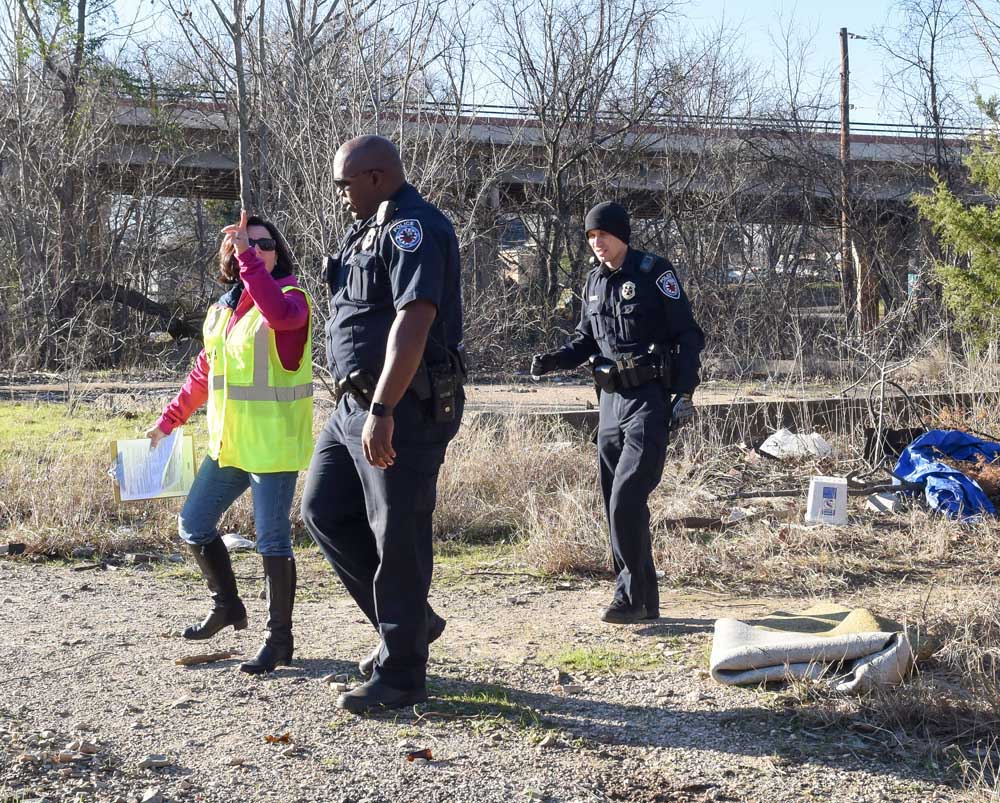Data: Tyler’s homeless population decreased from 2024 to 2025
Published 5:45 pm Wednesday, March 19, 2025

- Shane Jasper, center, works with other officers and volunteers to survey Tyler’s homeless population in 2017. (Tyler Morning Telegraph File)
Tyler’s homeless population has decreased since 2024, according to official numbers from the 2025 Point-in-Time Count for Smith County/Tyler.
In numbers provided to Tyler Morning Telegraph via the Texas Homeless Network, the 2025 PIT Count shows a 20.64% decrease in the city’s overall homeless population from 2024.
During the 2025 count held in January, volunteers counted 273 homeless people — less than 2024 when they counted 344 individuals. This is also less than the average of about 300 counted in the last seven PIT counts.
Although the overall numbers show a decrease of the homeless population, the data also reveals increases from 2024 in youth parents, veterans, and those impacted by health and domestic violence among the homeless population in Tyler. In addition, the data shows an increase in Black families with kids experiencing homelessness.
Goodwill Industries of East Texas led the 2025 PIT Count in January. Throughout the day, volunteers went to various locations — including known encampments and areas where those experiencing homelessness reside — to count the homeless population.
An accurate count is important to secure necessary funding. However, the count has to be done in one day. In addition, the Salvation Army does its own count of people who are staying in its shelter.
The numbers show increases since 2024 of homeless adults who are domestic violence survivors, have substance use disorder and HIV/AIDS. The largest increases were among those with HIV/AIDS and domestic violence survivors. Nearly a quarter more domestic violence survivors were reported in 2025 than 2024, increasing from 40 individuals to 53, and about 40% more had HIV/AIDS — an increase from four to 10.
Tyler Police Officer Shane Jasper, the Tyler Police Department Homeless Outreach Coordinator, noted there has been an increase in mental health issues among the homeless population. Jasper hopes to see more efforts to connect the homeless population to health services. Oftentimes people will refuse help, despite needing it, he said in a past interview with TylerPaper.
“Maybe (if) there was a medical location that they could go to and get the evaluation, and then go from there. That’s a start,” Jasper said in a previous interview with TylerPaper. “Right now, they’re not getting (to) any medical facility, once they were away from the family (or) person that was helping them get to those medical facilities.”
The 2024 Texas Homeless Inventory County shows households with children make up one-third of those experiencing homelessness. In contrast, households without children make up over half of households experiencing homelessness, according to the Texas Homeless Network.
The number of people experiencing chronic homelessness remained about the same. However, the number of homeless veterans increased from 16 to 19. In addition, the number of unaccompanied youth increased from 2024 — from 13 individuals to 19. Lastly, the number of youth parents doubled, increasing from one to two, and the number of youth households increased four times from one to four and veteran households with at least one child decreased in 2025 from one household to zero.
Nationally, homelessness among veterans has decreased 7.5% since 2023, according to the United States Department of Veterans Affairs. In Texas, the majority of veterans experiencing homelessness are individuals and men. Among veterans in Texas experiencing homelessness, 90% are men and 47.5% have a mental health disorder. In addition, the majority of veterans experiencing homelessness are 55 or older and have at least one disability, according to the Texas Homelessness Network.
People experience homelessness for multiple reasons including rising rent costs and low pay. The burden of housing costs affects people of color at higher rates. In addition, people of color are more likely to be renters. Among renters, Black people are 56% of renters, while white individuals are 28% of renters, according to the National Alliance to End Homelessness.
Among households with at least one child, the majority are Black households. They make up nearly 80% of households among the homeless population with children and in shelters. Although the number of households with at least one child decreased from 43 to 15, the percentage of Black individuals among the households increased from about 64% to 79%.
In contrast among individual households without kids, white individuals make up the majority of those experiencing homelessness. From 2024 to 2025, the numbers show an increase of about 21% — from 42% to 61% of white individual households. The majority of households without kids are white men. In addition, Black individuals in households without children increased 21% — from 52 individuals to 66.
For people experiencing homelessness, they can reach out to Tyler Street Team or The Salvation Army. In addition, people can visit PATH (People Attempting to Help) and the East Texas Food Bank for resources.






